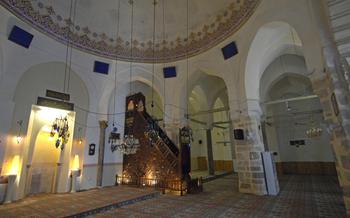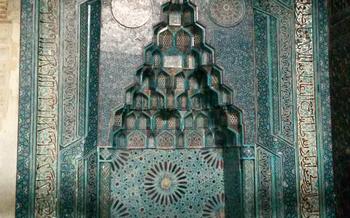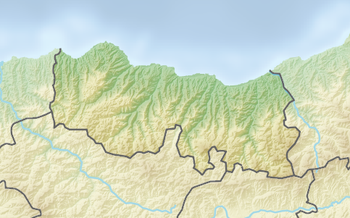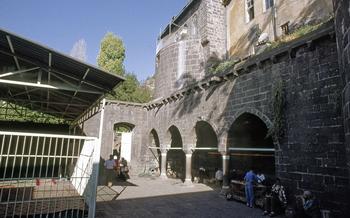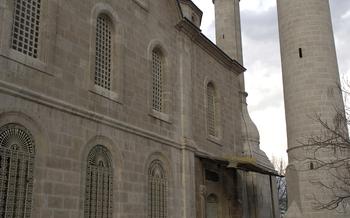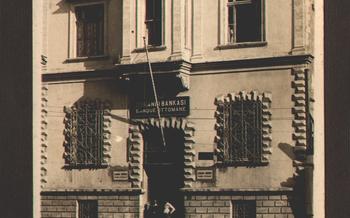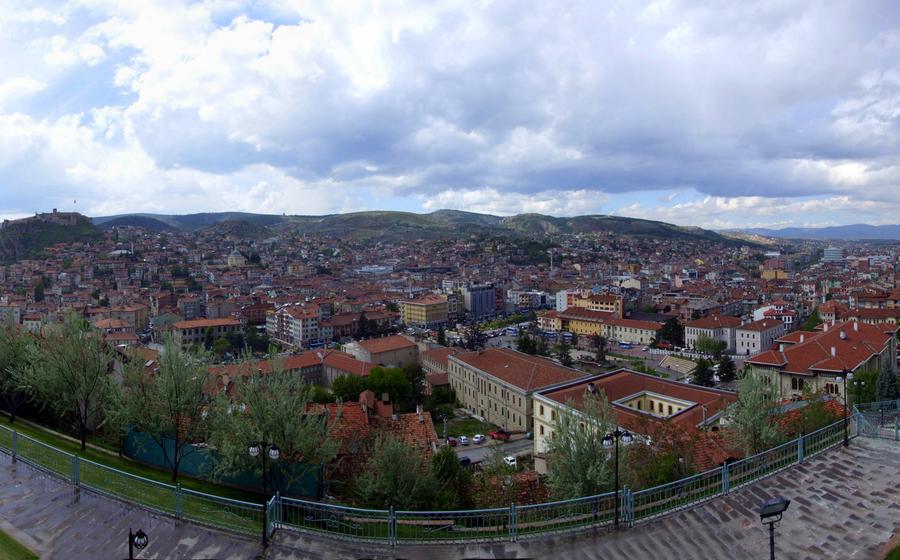
Iskender Pasha Mosque
- The Iskender Pasha Mosque: An Architectural Masterpiece
- Exploring the Mosque's Interior: A Journey Through History
- The Courtyard: A Place of Tranquility and Reflection
- The Prayer Hall: A Space for Spiritual Connection
- The Minaret: A Symbol of Divine Presence
- The Tomb of Iskender Pasha: A Legacy Remembered
- Discovering the History of the Mosque: A Tapestry of Civilizations
- Visiting Hours and Etiquette: Respecting Local Customs
- Guided Tours and Local Expertise: Enriching Your Experience
- The Mosque's Role in the Community: A Center for Social Cohesion
- Photography and Documentation: Capturing Memories
- Combining History with Nature: Exploring Kastamonu's Surroundings
- Local Cuisine and Delights: Savoring Kastamonu's Flavors
- Respecting Local Customs and Traditions: A Cultural Exchange
- Insider Tip: Unveiling Hidden Gems
The Iskender Pasha Mosque: An Architectural Masterpiece
The Iskender Pasha Mosque stands as a testament to the rich history and architectural prowess of Kastamonu. Built in the 17th century by the Ottoman governor, Iskender Pasha, the mosque is a blend of classical Ottoman and Seljuk architectural styles. Its striking features include a large central dome, four slender minarets, and an intricate facade adorned with intricate carvings and calligraphy. The mosque's harmonious proportions and elegant design create a sense of awe and tranquility, making it a must-visit attraction for anyone interested in Islamic architecture and history.
Exploring the Mosque's Interior: A Journey Through History
Venturing inside the Iskender Pasha Mosque unveils a realm of artistic marvels and sacred tranquility. The mosque's layout adheres to traditional Islamic architectural principles, featuring a central prayer hall flanked by side aisles. The vastness of the space is awe-inspiring, with intricate patterns and motifs adorning every surface.
The mosque's interior is bathed in a soft, ethereal light that filters through the stained-glass windows, casting a mesmerizing glow on the opulent Islamic calligraphy. Verses from the Quran, skillfully inscribed in elegant Arabic script, grace the walls and arches, creating a sacred ambiance that evokes a profound sense of spirituality.
Intricate artwork adorns every corner of the mosque, from the delicate floral motifs adorning the mihrab to the intricate geometric patterns that embellish the ceiling. Each piece of artwork holds symbolic meaning, narrating stories from Islamic history and culture, and collectively contributing to the mosque's rich visual tapestry.
The serene atmosphere within the mosque invites contemplation and spiritual reflection. The gentle murmur of prayers and the soft rustling of garments create a soothing soundscape that envelops visitors, allowing them to connect with their inner selves and find solace amidst the tranquility of this sacred space.
The Courtyard: A Place of Tranquility and Reflection
As you step into the courtyard of the Iskender Pasha Mosque, a sense of serenity and tranquility envelops you. Designed with meticulous attention to detail, the courtyard serves as a welcoming space for worshippers and visitors alike. Its expansive layout is adorned with intricate stonework and beautifully landscaped gardens, creating a harmonious balance between nature and architecture.
At the center of the courtyard, a mesmerizing water fountain stands tall, its gentle flow providing a soothing backdrop to the tranquil ambiance. The sound of water echoing through the courtyard adds an element of serenity, inviting you to pause and reflect. This water feature not only serves a practical purpose for ablution before prayer but also symbolizes purity and spiritual cleansing.
The courtyard's design is not merely functional but also deeply symbolic. Its symmetrical layout and the arrangement of walkways and benches encourage a sense of order and contemplation. As you wander through the courtyard, taking in the intricate details of the surrounding architecture, you can't help but feel a sense of awe and inspiration.
Whether seeking a moment of respite from the bustling city or a space for quiet reflection, the courtyard of the Iskender Pasha Mosque offers a sanctuary for both the body and the soul. It is a place where you can connect with your inner self, appreciate the beauty of Islamic art and architecture, and immerse yourself in the tranquility that this sacred space exudes.
The Prayer Hall: A Space for Spiritual Connection
The main prayer hall of the Iskender Pasha Mosque is a vast and awe-inspiring space that can accommodate hundreds of worshippers. Its layout is designed to facilitate the orderly flow of prayer, with rows of carpets arranged in neat lines facing the qibla wall. The intricate details of the mihrab, the niche indicating the direction of Mecca, and the minbar, the raised pulpit from which the imam delivers the sermon, are particularly noteworthy. The mihrab is adorned with exquisite calligraphy and intricate tilework, while the minbar is made of finely carved wood and features intricate geometric patterns.
The acoustics of the prayer hall are remarkable, amplifying the imam's voice and creating a reverberating effect that enhances the spiritual atmosphere. During prayer time, the hall buzzes with a sense of unity and devotion as worshippers stand shoulder to shoulder, bowing and prostrating in unison. The air is filled with the rhythmic recitation of verses from the Quran, creating a serene and meditative environment that fosters a deep connection with the divine.
The Minaret: A Symbol of Divine Presence
Towering over the Iskender Pasha Mosque, the minaret stands as a majestic symbol of divine presence. Its slender structure, adorned with intricate tilework and delicate balconies, reaches towards the heavens, guiding the faithful towards their spiritual journey. The minaret's height and prominence serve as a beacon of light, beckoning worshippers from afar to gather within the mosque's sacred walls.
In Islamic architecture, the minaret holds significant importance, representing the connection between the earthly realm and the divine. From its elevated position, the muezzin's melodious call to prayer echoes through the surrounding streets, inviting the community to unite in devotion. The minaret's distinctive silhouette against the backdrop of Kastamonu's cityscape serves as a reminder of the deep-rooted Islamic heritage embedded within this historic city.
As the sun casts its golden rays upon the minaret, it illuminates the intricate carvings and decorative elements that adorn its exterior. These intricate details showcase the remarkable craftsmanship and artistic prowess of the mosque's builders. The minaret's presence adds an air of grandeur to the mosque's overall architecture, emphasizing its status as a prominent landmark and a symbol of faith in Kastamonu.
The Tomb of Iskender Pasha: A Legacy Remembered
Within the grounds of the Iskender Pasha Mosque lies the tomb of its namesake, Iskender Pasha, a revered figure in Kastamonu's history. The tomb, adorned with intricate carvings and inscriptions, serves as a testament to his remarkable life and achievements.
Pasha, who lived from 1490 to 1572, was a prominent Ottoman statesman and military commander. He played a pivotal role in the expansion and consolidation of the Ottoman Empire. His conquests in the Caucasus region, particularly his capture of the strategic fortress of Tiflis (present-day Tbilisi), earned him the title of "Fatih" (Conqueror).
The tomb, located in a serene corner of the mosque's courtyard, reflects the deep respect and admiration held for Pasha. Its design, featuring a domed roof supported by slender columns, showcases the architectural influences of the Ottoman era.
Visitors can pay their respects at the tomb and learn about Pasha's remarkable contributions to the Ottoman Empire. His legacy continues to inspire generations, serving as a reminder of the rich history and cultural heritage of Kastamonu.
Discovering the History of the Mosque: A Tapestry of Civilizations
The Iskender Pasha Mosque stands as a testament to Kastamonu's rich and diverse history, reflecting the influences of various cultures and architectural styles that have shaped the city over time. Built in the 16th century during the Ottoman era, the mosque incorporates elements of traditional Islamic architecture, blending seamlessly with the city's Anatolian heritage.
The mosque's construction and evolution over time mirror the city's own transformation. Initially built as a small prayer space, it underwent significant expansions and renovations during the 18th and 19th centuries, reflecting the city's growing prosperity and importance. The mosque's architecture showcases a harmonious blend of Ottoman, Seljuk, and Byzantine influences, each contributing to its unique aesthetic and grandeur.
Exploring the mosque's intricate details and architectural features allows visitors to trace the footsteps of history, gaining insights into the cultural and religious heritage of Kastamonu. The mosque stands as a living testament to the city's ability to absorb and integrate diverse influences, creating a rich tapestry of architectural styles that reflects its vibrant past.
Visiting Hours and Etiquette: Respecting Local Customs
When visiting the Iskender Pasha Mosque, it is essential to show respect for local customs and etiquette. Dress modestly and avoid wearing clothing that is too revealing or tight-fitting. Women should cover their hair as a sign of respect. Before entering the mosque, remove your shoes and place them on the designated shelves. It is customary to perform ablution before prayer, and facilities are available for this purpose.
The mosque is open to visitors daily, but it is important to be mindful of the prayer schedule. During prayer times, it is advisable to remain quiet and avoid disturbing worshippers. If you wish to take photographs, be sure to ask permission first and avoid using flash photography. It is also important to be respectful of the mosque's sacred nature and refrain from engaging in loud conversations or other disruptive behavior.
By following these guidelines, you can ensure that your visit to the Iskender Pasha Mosque is both enjoyable and respectful of local customs.
Guided Tours and Local Expertise: Enriching Your Experience
Guided tours are an excellent way to delve deeper into the history, architecture, and cultural significance of the Iskender Pasha Mosque. Knowledgeable local guides can provide insights and anecdotes that bring the mosque's story to life. They can explain the intricacies of the mosque's design, point out hidden details, and share fascinating stories about its past.
Booking a guided tour is easy. Many local tour operators offer guided tours of the mosque, which can be arranged in advance or on arrival. Be sure to choose a reputable tour operator that employs experienced and knowledgeable guides.
The cost of guided tours varies depending on the tour length, group size, and inclusions. However, the investment is well worth it for the wealth of information and insights you'll gain.
If you prefer a more personalized experience, consider hiring a private guide. Private guides can tailor the tour to your specific interests and pace and offer a more in-depth exploration of the mosque.
Whether you choose a group or private tour, taking advantage of local expertise is the best way to make the most of your visit to the Iskender Pasha Mosque.
The Mosque's Role in the Community: A Center for Social Cohesion
The Iskender Pasha Mosque serves as a vital hub for the local community, fostering a sense of belonging and social cohesion among its members. Beyond its religious significance, the mosque has evolved into a multi-faceted center that caters to the diverse needs of the community. It hosts educational programs, social gatherings, and charitable events, creating a vibrant and inclusive environment for people of all ages and backgrounds.
The mosque's courtyard, with its serene ambiance and inviting atmosphere, serves as a communal space where people can gather, socialize, and exchange ideas. It is a place where friendships are formed, community bonds are strengthened, and a sense of unity is cultivated. The mosque also plays a crucial role in providing support and assistance to those in need, embodying the principles of compassion, charity, and social responsibility.
Photography and Documentation: Capturing Memories
When visiting the Iskender Pasha Mosque, capturing the beauty and grandeur of this architectural masterpiece through photography is a natural instinct. However, it's crucial to do so respectfully, mindful of the sacred nature of the site.
Guidelines for Respectful Photography
Prioritize Modesty: Dress modestly and avoid wearing revealing clothing, respecting the mosque's religious significance.
Permission and Courtesy: Always ask permission before photographing people, especially if they are engaged in prayer or religious activities.
No Flash Photography: Refrain from using flash photography, as it can be disruptive and distracting during prayer times.
Focus on Details: Capture the intricate details of the mosque's architecture, such as the tilework, calligraphy, and carvings.
Wide-Angle Perspective: Utilize a wide-angle lens to capture the mosque's vast interior and exterior, showcasing its grandeur.
Minimal Editing: Edit your photos minimally, preserving the mosque's authentic colors and atmosphere.
Share Respectfully: When sharing your photographs online or in print, provide context and acknowledge the mosque's significance.
Tips for Capturing the Mosque's Beauty
Golden Hour Magic: Visit the mosque during the golden hours of sunrise or sunset to capture the warm, ethereal light.
Symmetry and Lines: Take advantage of the mosque's symmetrical architecture and leading lines to create visually appealing compositions.
Experiment with Angles: Explore different angles to capture unique perspectives, such as from the courtyard or the minaret's base.
Interior Details: Focus on the intricate details of the interior, such as the calligraphy, stained glass windows, and chandeliers.
People and Activity: Capture the mosque's vibrant atmosphere by photographing people engaged in prayer, contemplation, or conversation.
Reflections and Silhouettes: Utilize reflective surfaces, such as water features or mirrors, to create interesting reflections.
Document Your Experience: Take photos of your journey to the mosque, including the surrounding streets and local life, to create a comprehensive narrative.
By following these guidelines and tips, you can capture the essence of the Iskender Pasha Mosque while respecting its sacred nature and preserving its beauty for future generations.
Combining History with Nature: Exploring Kastamonu's Surroundings
Kastamonu, with its rich history and natural beauty, offers a plethora of destinations to explore beyond the Iskender Pasha Mosque. History buffs will find solace in the imposing Kastamonu Castle, a testament to the city's medieval past, or the intriguing Ilgar Mountain Tombs, offering a glimpse into ancient civilizations.
Nature enthusiasts, on the other hand, can revel in the breathtaking vistas of the Ilgaz Mountain National Park, a haven for outdoor adventurers. The park boasts an array of hiking trails, verdant forests, and pristine lakes, inviting visitors to embrace the tranquility of nature.
For a unique experience, consider venturing to the Seydiler Canyon, a natural wonder known for its towering rock formations and cascading waterfalls. Take a leisurely stroll along the canyon's rim, marveling at the sheer beauty of nature's artistry.
To further enrich your journey, embark on a day trip to the picturesque town of Safranbolu, a UNESCO World Heritage Site. Wander through its charming streets, lined with traditional Ottoman houses, and immerse yourself in the town's rich history and culture.
By combining the exploration of Kastamonu's historical landmarks with its natural wonders, you'll create a well-rounded itinerary that caters to diverse interests and leaves you with unforgettable memories.
Local Cuisine and Delights: Savoring Kastamonu's Flavors
Kastamonu's culinary scene offers a tantalizing array of traditional dishes and local delicacies that will delight your palate. Immerse yourself in the flavors of the region by sampling these must-try specialties:
-
Kastamonu Mantısı: These delicate dumplings, filled with minced meat and herbs, are a local favorite. Served with a generous dollop of yogurt and a drizzle of garlic-infused oil, they burst with flavor.
-
Çiğ Börek: Layers of thin dough filled with a mixture of herbs, cheese, and sometimes minced meat create this crispy and savory pastry. It's a popular snack or light meal that can be enjoyed on the go.
-
Kuyu Kebabı: This slow-cooked lamb dish is a culinary masterpiece. Tender lamb, marinated in spices and cooked in a clay pot, falls off the bone and melts in your mouth.
-
Kastamonu Pidesi: These flatbreads are topped with various ingredients, such as cheese, minced meat, or vegetables. The crispy crust and flavorful fillings make them a hearty and satisfying meal.
-
Kestane Şekeri: Kastamonu is renowned for its sweet chestnut confectionery. These glazed chestnuts, candied in sugar syrup, are a delightful treat that will satisfy your sweet tooth.
To savor the authentic flavors of Kastamonu, venture into the local restaurants and cafes. Ask for recommendations and embrace the opportunity to interact with the friendly locals. Many restaurants offer outdoor seating, allowing you to soak in the vibrant atmosphere while enjoying your meal.
Remember, food is an integral part of any travel experience. By indulging in Kastamonu's culinary delights, you'll not only satisfy your taste buds but also gain a deeper appreciation for the region's culture and heritage.
Respecting Local Customs and Traditions: A Cultural Exchange
When visiting the Iskender Pasha Mosque and Kastamonu as a whole, it is essential to be mindful of local customs and traditions to ensure a respectful and enriching experience. Dressing modestly and behaving respectfully within the mosque is paramount. During prayer times, it is advisable to maintain silence and avoid disturbing worshippers. When interacting with locals, a friendly and polite demeanor is highly valued. Learning a few Turkish phrases, such as "Merhaba" for hello and "Teşekkür ederim" for thank you, can go a long way in fostering cultural exchange. Remember, you are a guest in their country, and showing respect for their customs will create a positive and memorable experience for all.
Insider Tip: Unveiling Hidden Gems
As you explore the Iskender Pasha Mosque, don't miss the opportunity to uncover its hidden treasures. Venture beyond the main prayer hall and courtyard to discover the mosque's lesser-known corners. In the mosque's serene library, you'll find a collection of ancient manuscripts and Islamic texts that offer a glimpse into the mosque's rich history.
Step outside the mosque and explore the surrounding neighborhood, where you'll find hidden gems waiting to be discovered. Just a short walk away, you'll come across the picturesque Kasaba Hamam, a historical bathhouse that has been beautifully restored and is now open to the public. Immerse yourself in the traditional Turkish bathing experience and enjoy a moment of relaxation and rejuvenation.
For a unique perspective of the mosque and the city, climb to the top of the nearby Kale Hill. This hilltop offers panoramic views of Kastamonu, with the mosque's minarets standing tall in the foreground. Capture breathtaking photos and create lasting memories of your visit to this enchanting city.

